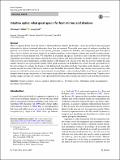Intuitive optics : what great apes infer from mirrors and shadows
Abstract
There is ongoing debate about the extent to which nonhuman animals, like humans, can go beyond first-order perceptual information to abstract structural information from their environment. In order to provide more empirical evidence regarding this question, we examined what type of information great apes (chimpanzees, bonobos, and orangutans) gain from optical effects such as shadows and mirror images. In an initial experiment, we investigated whether apes would use mirror images and shadows to locate hidden food. We found that all examined ape species used these cues to find the food. Follow-up experiments showed that apes neither confused these optical effects with the food rewards nor did they merely associate cues with food. First, naïve chimpanzees used the shadow of the hidden food to locate it but they did not learn within the same number of trials to use a perceptually similar rubber patch as indicator of the hidden food reward. Second, apes made use of the mirror images to estimate the distance of the hidden food from their own body. Depending on the distance, apes either pointed into the direction of the food or tried to access the hidden food directly. Third, apes showed some sensitivity to the geometrical relation between mirror orientation and mirrored objects when searching hidden food. Fourth, apes tended to interpret mirror images and pictures of these mirror images differently depending on their prior knowledge. Together, these findings suggest that apes are sensitive to the optical relation between mirror images and shadows and their physical referents.
Citation
Völter , C J & Call , J 2018 , ' Intuitive optics : what great apes infer from mirrors and shadows ' , Animal Cognition , vol. First Online . https://doi.org/10.1007/s10071-018-1184-0
Publication
Animal Cognition
Status
Peer reviewed
ISSN
1435-9448Type
Journal article
Collections
Items in the St Andrews Research Repository are protected by copyright, with all rights reserved, unless otherwise indicated.

